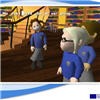

Chatbot listing, virtual agents, virtual assistants, chat bot directory, conversational agents, virtual human news, chatterbot list
NEWS: Chatbots.org survey on 3000 US and UK consumers shows it is time for chatbot integration in customer service!read more..
Fearnot!

|
FearNot! is an interactive drama/video game that teaches children strategies to prevent bullying and social exclusion. It originates from the EU funded research projects Victec and eCircus. The software uses innovative psychology inspired character AI.
Additional comments by developer E-circus: VICTEC (Virtual ICT with Empathic Characters), a European framework V project was carried out between 2002-2005. The project considered the application of 3D animated synthetic characters and emergent narrative to create improvised dramas to address bullying problems for children aged 8-12 in the UK, Germany and Portugal. One of the main aims of the project was to develop synthetic characters that could, through their appearances, behaviours and features allow the user to build empathic relations with them. The project's pedagogical objectives were met through the design and implementation of interactive, episodic and emergent virtual dramas where children were exposed to bullying scenarios in a safe school-based Virtual Learning Environment (VLE). The FearNot! application software (Fun with Empathic Agents to Achieve Novel Outcomes in Teaching) developed during the project aimed to enable children to explore physical and relational bullying issues and coping strategies through empathic interactions with synthetic characters. In order to achieve these objectives, FearNot! provides children with various scenarios about bullying behaviour, that promote engagement and believability with synthetic characters in a social interaction [Figure 1]. Extensive evaluations of the FearNot application with over 1,000 children were carried out to consider children's engagement with the synthetic agents, and their empathic responses to the characters and the scenarios. Individual interaction styles in relation to bullying behaviour, and children's Theory of Mind abilities were also explored. The project also permitted technological advancement in the domains, of intelligent and synthetic agents, artificial intelligence and emotion modelling. Furthermore, due to its close collaboration and involvement with schools and pupils, the VICTEC project allowed the development of an ad-hoc technical tool for dealing with ethically sensitive issues. The project was successfully received both from a technical and psychological perspective. However, a number of exciting unexplored research questions arose, which were out of the scope of the VICTEC project. The ECIRCUS project aims to address some of these novel questions within a more educationally focused project. To generate social immersion will require the child to be in a position where he/she will be willing to engage with the problems faced by the victimised character. This required the child to act as an "invisible friend" - invisible because they are not themselves present in the dramatic episodes, and friend because they can advise and support the character but not act with god-like power to solve their problems for them. The success of the Japanese Tamagotchis - small plastic capsules with rudimentary graphics expressing their "needs" for food, cleanliness and play - suggests that children indeed feel a sense of responsibility for the articulated needs of electronic characters. In the case of FearNot! these needs are emotional rather than physical and for this reason the child's relationship with the character and their social understanding of the character's situation are essential in providing honest advice reflecting on the users' affective relationship with the character. The structure of FearNot! was inspired by the forum theatre approach developed by Brazilian dramatist Augusto Boal [1] in order to incorporate theatre into the development of political activism. In this dramatic form, an audience is split into groups, with each group taking responsibility for one of the characters in the drama. Between episodes of dramatic enactment, each group meets the actor, who stays in role, and negotiates with them what they should do next in the drama, respecting the constraints of their role and character. This structure of dramatic episodes divided by periods in which advice can be given to a character has been adopted for FearNot!. The child user interacts with one physical bullying scenario and one relational scenario. After the introduction of the characters, school and situation, users view the first bullying episode, followed by the victimised character seeking rescue in the school library, where it starts to communicate with the child user. Within the initiated dialogue the user selects an advice from a list of coping strategies (shown as a drop down menu). The user also explains his/her selection and what he/she thinks will happen after having implemented the selected strategy, by typing it in. The next episode then starts. The content of the final episode depends on the choices made by the user concerning the coping strategies: Paul, the bystander in the physical bullying scenario, might act as a defender for John (the victim), in case the user has selected a successful strategy, i.e. "telling someone"; or Martina (the bystander) might offer Frances (the victim) help. However, if the user has selected a unsuccessful strategy, i.e. "run away", the victim rejects the help in the final episode. At the end of the scenario, a universal educational message is displayed pointing out that "telling someone you trust" is usually a good choice. This universal message had to be incorporated as all teachers had strong preferences for children to finish the interaction with a positive feedback message. |
2 honors & awards for Fearnot!
- Machine intelligence competition 2007 - Machine Intelligence Competition overall - finalist
- Machine intelligence competition 2006 - Machine Intelligence Competition overall - finalist














 Grey out:
Grey out: